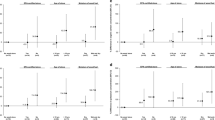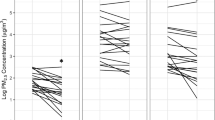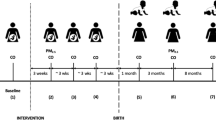Abstract
Wood is commonly used for residential heating, but there are limited evidence-based interventions for reducing wood smoke exposures in the indoor environment. The Asthma Randomized Trial of Indoor Wood Smoke (ARTIS) study was designed to assess the efficacy of residential interventions to reduce indoor PM exposure from wood stoves. As part of a three-arm randomized placebo-controlled trial, two household-level interventions were evaluated: wood stove changeouts and air filtration units. Exposure outcomes included indoor measures such as continuous PM2.5, particle counts, and carbon monoxide. Median indoor PM2.5 concentration was 17.5 μg/m3 in wood-burning homes prior to interventions. No significant reductions in PM2.5 concentrations were observed in the 40 homes receiving the placebo filter intervention. Sixteen homes received the wood stove changeout and showed no significant changes in PM2.5 or particle counts. PM2.5 concentrations were reduced by 68% in the filter intervention homes. Relative to placebo, air filtration unit homes had an overall PM2.5 reduction of 63% (95% CI: 47–75%). Relative to the wood stove changeout, the filtration unit intervention was more efficacious and less expensive, yet compliance issues indicated a need for the evaluation of additional strategies for improving indoor air quality in homes using wood stoves.
This is a preview of subscription content, access via your institution
Access options
Subscribe to this journal
Receive 6 print issues and online access
$259.00 per year
only $43.17 per issue
Buy this article
- Purchase on Springer Link
- Instant access to full article PDF
Prices may be subject to local taxes which are calculated during checkout


Similar content being viewed by others
References
U.S. Department of Energy (USDOE). Table HC6.7. Space heating in U.S. homes, by census region, Washington, DC, 2009.
Air Quality Management Work Group (AQMWG) Recommendations to the Clean Air Act Advisory Committee: Phase I and Next Steps, Washington, DC, 2005.
Larson T, Gould T, Simpson C, Liu LJ, Claiborn C, Lewtas J . Source apportionment of indoor, outdoor, and personal PM2.5 in Seattle, Washington, using positive matrix factorization. J Air Waste Manag Assoc 2004; 54: 1175–1187.
Naeher LP, Brauer M, Lipsett M, Zelikoff JT, Simpson CD, Koenig JQ et al. Woodsmoke health effects: a review. Inhal Toxicol 2007; 19: 67–106.
Ward T, Lange T . The impact of wood smoke on ambient PM2.5 in northern Rocky Mountain valley communities. Environ Pollut 2010; 158: 723–729.
Ward TJ, Trost B, Conner J, Flanagan J, Jayanty RKM . PM2.5 source apportionment in a subarctic airshed—Fairbanks, Alaska. Aero Air Qual Res 2012; 12: 536–543.
Allen R, Leckie S, Millar G, Brauer M . The impact of wood stove technology upgrades on indoor residential air quality. Atmos Env 2009; 43: 5908–5915.
Ward T, Boulafentis J, Simpson J, Hester C, Moliga T, Warden K et al. Lessons learned from a woodstove changeout on the Nez Perce Reservation. Sci Total Environ 2011; 409: 664–670.
Noonan CW, Navidi W, Sheppard L, Palmer CP, Bergauff M, Hooper K et al. Residential indoor PM2.5 in wood stove homes: follow-up of the Libby changeout program. Indoor Air 2012a; 22: 492–500.
Semmens EO, Noonan CW, Allen RW, Weiler EC, Ward TJ . Indoor particulate matter in rural, wood stove heated homes. Environ Res 2015; 138C: 93–100.
Noonan CW, Ward TJ, Navidi W, Sheppard L . A rural community intervention targeting biomass combustion sources: effects on air quality and reporting of children’s respiratory outcomes. Occ Environ Med 2012b; 69: 354–360.
Jenkins P, Phillips T, Mulberg J, Hui S . Activity patterns of Californians: use of and proximity to indoor pollutant sources. Atmos Res 1992; 26A: 2141–2148.
Lim SS, Vos T, Flaxman AD, Danaei G, Shibuya K, Adair-Rohani H et al. A comparative risk assessment of burden of disease and injury attributable to 67 risk factors and risk factor clusters in 21 regions, 1990-2010: a systematic analysis for the Global Burden of Disease Study 2010. Lancet 2012; 380: 2224–2260.
Torres-Duque C, Maldonado D, Perez-Padilla R, Ezzati M, Viegi G . Biomass fuels and respiratory diseases: a review of the evidence. Proc Am Thorac Soc 2008; 5: 577–590.
Diette GB, Accinelli RA, Balmes JR, Buist AS, Checkley W, Garbe P et al. Obstructive lung disease and exposure to burning biomass fuel in the indoor environment. Global Heart 2012; 7: 265–270.
Sood A . Indoor fuel exposure and the lung in both developing and developed countries: an update. Clin Chest Med 2012; 33: 649–665.
Noonan CW, Ward TJ . Asthma randomized trial of indoor wood smoke (ARTIS): rationale and methods. Contemp Clin Trials 2012; 33: 1080–1087.
Semmens E, Noonan C, Ward T, Hester C . Are indoor air filters a sustainable intervention for reducing indoor particulate exposures? Epidemiology 2012; 23: S638.
McNamara ML, Noonan CW, Ward TJ . Correction factor for continuous monitoring of wood smoke fine particulate matter. Aero Air Qual Res 2011; 11: 315–322.
Hays MD, Geron CD, Linna KJ, Smith ND, Schauer JJ . Speciation of gas-phase and fine particle emissions from burning of foliar fuels. Environ Sci Technol 2002; 36: 2281–2295.
Ward TJ, Palmer C, Bergauff M, Hooper K, Noonan CW . Results of a residential indoor PM2.5 sampling program before and after a wood- stove changeout. Indoor Air 2008; 18: 408–415.
U.S. Environmental Protection Agency (US EPA). Consumers—best burn practices. Available at: http://www.epa.gov/burnwise/bestburn.html (accessed on 10 January 2012).
Burnett RT, Pope CA, III, Ezzati M, Olives C, Lim SS, Mehta S et al. An integrated risk function for estimating the global burden of disease attributable to ambient fine particulate matter exposure. Environ Health Perspect 2014; 122: 397–403.
Reisman RE, Mauriello PM, Davis GB, Georgitis JW, DeMasi JM . A double-blind study of the effectiveness of a high-efficiency particulate air (HEPA) filter in the treatment of patients with perennial allergic rhinitis and asthma. J Allergy Clin Immunol 1990; 85: 1050–1057.
Eggleston PA, Butz A, Rand C, Curtin-Brosnan J, Kanchanaraksa S, Swartz L et al. Home environmental intervention in inner-city asthma: a randomized controlled clinical trial. Ann Allergy Asthma Immunol 2005; 95: 518–524.
Hart JF, Ward TJ, Spear TM, Rossi RJ, Holland NN, Loushin BG . Evaluating the effectiveness of a commercial portable air purifier in homes with wood burning stoves: a preliminary study. J Environ Public Health 2011; 2011: 1–7.
Wheeler AJ, Gibson MD, MacNeill M, Ward TJ, Wallace LA, Kuchta J et al. Impacts of air cleaners on indoor air quality in residences impacted by wood smoke. Environ Sci Technol 2014; 48: 12157–12163.
Allen R, Carlsten C, Karlen B, Leckie S, van Eeden S, Vedal S et al. An air filter intervention study of endothelial function among healthy adults in a woodsmoke-impacted community. Am J Respir Crit Care Med 2011; 183: 1222–1230.
Barn P, Larson T, Noullett M, Kennedy S, Copes R, Brauer M . Infiltration of forest fire and residential wood smoke: an evaluation of air cleaner effectiveness. J Expo Sci Environ Epi 2008; 18: 503–511.
Acknowledgements
We thank Carolyn Hester, Marcy McNamara, Luke Montrose, Johna Boulafentis, Stacey Harper, Kathrene Conway, and Nicole Swensgard for data collection efforts. We are also grateful to the participants and their families for the considerable time and effort put into the study. This research was supported by NIEHS (1R01ES016336–01 and 3R01ES016336–02S1), with partial support from NCRR (COBRE P20RR 017670). We thank John Balmes and Kirk Smith for their advice on study design, and 3M (Andy Fox and Kevin Kinzer) for advice and materials in the design of the placebo filter.
Author information
Authors and Affiliations
Corresponding author
Ethics declarations
Competing interests
The authors declare no conflict of interest.
Additional information
Supplementary Information accompanies the paper on the Journal of Exposure Science and Environmental Epidemiology website
Supplementary information
Rights and permissions
About this article
Cite this article
Ward, T., Semmens, E., Weiler, E. et al. Efficacy of interventions targeting household air pollution from residential wood stoves. J Expo Sci Environ Epidemiol 27, 64–71 (2017). https://doi.org/10.1038/jes.2015.73
Received:
Revised:
Accepted:
Published:
Issue Date:
DOI: https://doi.org/10.1038/jes.2015.73
Keywords
This article is cited by
-
Bronchiolitis recovery and the use of High Efficiency Particulate Air (HEPA) Filters (The BREATHE Study): study protocol for a multi-center, parallel, double-blind, randomized controlled clinical trial
Trials (2024)
-
Randomized trial in rural Native American homes heated with wood stoves: results from the EldersAIR study
Air Quality, Atmosphere & Health (2024)
-
Air Pollution Control Technologies for Indoor Particulate Matter Pollution: A Review
Aerosol Science and Engineering (2023)
-
Residential wood stove use and indoor exposure to PM2.5 and its components in Northern New England
Journal of Exposure Science & Environmental Epidemiology (2020)
-
Dietary intake is associated with respiratory health outcomes and DNA methylation in children with asthma
Allergy, Asthma & Clinical Immunology (2017)



